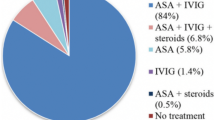Abstract
Kawasaki disease is an acute systemic vasculitis which can cause cardiac involvement among other symptoms. In this study we aimed to assess the relationship between the echocardiographic findings of Kawasaki disease with the clinical and paraclinical findings of the patients. In this cross-sectional study, the symptoms of 307 Kawasaki patients were registered and the association of the symptoms with paraclinical findings and echocardiographic studies was assessed. 190 (61.9%) of the patients were male and 117 (38.1%) were female. 193 patients (62.9%) did not have any abnormalities in their echocardiography, while others showed coronary artery aneurysms, perivascular brightness, coronary artery dilatation, and trivial Mitral Regurgitation in their echocardiography. A significant inverse relationship was seen with echocardiographic findings and age. Thrombocytosis, conjunctivitis, and oral and/or pharyngeal erythema and/or strawberry tongue were associated with higher rates of echocardiographic abnormalities. Echocardiographic abnormalities are associated with younger age, higher platelets, and the existence of conjunctivitis and oral and/or pharyngeal erythema and/or strawberry tongue.
Similar content being viewed by others
References
Kawasaki T (1967) Acute febrile mucocutaneous syndrome with lymphoid involvement with specific desquamation of the fingers and toes in children. Arerugi 16:178–222
Holman RC, Belay ED, Christensen KY, Folkema AM, Steiner CA, Schonberger LB (2010) Hospitalizations for Kawasaki syndrome among children in the United States, 1997–2007. Pediatr Infect Dis J 29(6):483–488
Makino N, Nakamura Y, Yashiro M, Ae R, Tsuboi S, Aoyama Y, et al (2015) Descriptive epidemiology of Kawasaki disease in Japan, 2011–2012: from the results of the 22nd nationwide survey. J Epidemiol, JE20140089.
McCrindle BW, Rowley AH, Newburger JW, Burns JC, Bolger AF, Gewitz M et al (2017) Diagnosis, treatment, and long-term management of Kawasaki disease: a scientific statement for health professionals from the American Heart Association. Circulation 135(17):e927–e999
Edraki MR, Mohammadi H, Mehdizadegan N, Ghorashi M, Amoozgar H, Borzouee M, Ajami G, Keshavarz K, Dehghani E, Bahrami R (2020) Japanese Kawasaki disease scoring systems: are they applicable to the Iranian population? Arch Iran Med 23(1):31–36 (PMID: 31910632)
Takahashi M, Mason W, Acherman R et al (2003) Is perivascular echo brightness a reliable marker of coronary arteritis in acute kawasaki syndrome? Pediatr Res 53:177. https://doi.org/10.1203/00006450-200301000-00139
Satou GM, Giamelli J, Gewitz MH (2007) Kawasaki disease: diagnosis, management, and long-term implications. Cardiol Rev 15(4):163–169
Kawamura Y, Kanai T, Takeshita S, Nonoyama S (2014) Use of the urinary trypsin inhibitor ulinastatin for acute Kawasaki disease. Nihon Rinsho Japan J Clin Med 72(9):1650–1653
Sayyed Hesamedin N, Mojgan S, Reza A (2006) Hair loss as a sign of Kawasaki disease.
Ali Adib AF, Nabavizadeh SH, Alyasin S, Kashef S (2017) Atypical desquamation in a 25-year-old boy with Kawasaki disease: a case report. Electronic Physician. 9(2):3764
Farvardin M, Kashef S, Aleyasin S, Nabavizadeh SH, Safari M (2007) Sudden unilateral blindness in a girl with Kawasaki disease. J Pediatr Ophthalmol Strabismus 44(5):303
Wood L, Tulloh R (2007) Kawasaki disease: diagnosis, management and cardiac sequelae. Expert Rev Cardiovasc Ther 5(3):553–561
Pfafferott C, Wirtzfeld A, Permanetter B (1997) Atypical Kawasaki syndrome: how many symptoms have to be present? Heart 78(6):619–621
A’rabi Moghadam M, Meraji S, Sayadpour K (2004) Study of cardial involvement prevalence in 61 pediatric cases of Kawasaki disease. Razi J Med Sci 11(41):361–365
Amirimoghadam Z, Molaee S, REZA ZM, Ghaneei Z, Babaei HA, Hemati R (2013) Assessment heart involvement in patients with Kawasaki disease.
Akagi T, Inoue O, Ohara N, Toyoda O, Rikitake N, Mikajima T et al (1989) Valvular regurgitation in patients with Kawasaki disease and in healthy children: a pulsed Doppler echocardiographic study. J Cardiol 19(3):787–796
de La Harpe M, di Bernardo S, Hofer M, Sekarski N (2019) Thirty Years of Kawasaki disease: a single-center study at the university hospital of lausanne. Front Pediatr 30(7):11. https://doi.org/10.3389/fped.2019.00011.PMID:30761279;PMCID:PMC6363689
Rabinowitz EJ, Rubin LG, Desai K, Hayes DA, Tugertimur A, Kwon EN et al (2019) Examining the utility of coronary artery lack of tapering and perivascular brightness in incomplete Kawasaki disease. Pediatr Cardiol 40(1):147–153
Frey EE, Matherne G, Mahoney L, Sato Y, Stanford W, Smith W (1988) Coronary artery aneurysms due to Kawasaki disease: diagnosis with ultrafast CT. Radiology 167(3):725–726
Advani N, Sastroasmoro S, Ontoseno T, Uiterwaal CS (2018) Long-term outcome of coronary artery dilatation in Kawasaki disease. Ann Pediatr Cardiol 11(2):125
Anderson MS, Burns J, Treadwell TA, Pietra BA, Glode MP (2001) Erythrocyte sedimentation rate and C-reactive protein discrepancy and high prevalence of coronary artery abnormalities in Kawasaki disease. Pediatr Infect Dis J 20(7):698–702
Ayyazi P, Mohammadzade G, Aryanfar F (2007) Clinical and laboratory finding of Kawasaki disease in children in Ghods hospital of Ghazvin. J Qazvin Univ MedSci Health Serv 11(1):28–33
Acknowledgements
The authors would like to thank the research and technology deputy of Shiraz University of Medical Sciences for their financial support. The authors have received a financial grant by the code 18866.
Author information
Authors and Affiliations
Corresponding author
Ethics declarations
Conflict of interest
The authors of this manuscript have no conflict of interest.
Additional information
Publisher's Note
Springer Nature remains neutral with regard to jurisdictional claims in published maps and institutional affiliations.
Rights and permissions
About this article
Cite this article
Nabavizadeh, S.H., Mehdizadegan, N., Moeini, M. et al. Assessing the Association of Kawasaki Disease Symptoms and Echocardiographic Findings. Pediatr Cardiol 43, 816–820 (2022). https://doi.org/10.1007/s00246-021-02792-x
Received:
Accepted:
Published:
Issue Date:
DOI: https://doi.org/10.1007/s00246-021-02792-x




